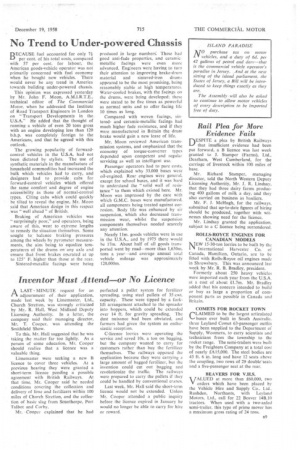No Trend to Under-powered Chassis
Page 43

If you've noticed an error in this article please click here to report it so we can fix it.
BECAUSE fuel accounted for only 71 per cent. of his total costs, compared with 57 per cent. for labour, the American goods-vehicle operator was not primarily concerned with fuel economy when he bought new vehicles. There would never be any trend in America towards building under-powered chassis.
This opinion was expressed yesterday by Mr. John P. Moon, A,M.I.R.T.E., technical editor of The Commercial Motor, when he addressed the Institute of Road Transport Engineers in London on "Transport Developments in the U.S.A." He added that the thought of running a vehicle of even 20 tons gross with an engine developing less than 120 b.h.p, was completely foreign to the Americans, and that he agreed with this outlook.
The growing popularity of forwardcontrol vehicles in the U.S.A. had not been dictated by stylists. The use of synthetic materials in the manufacture or household commodities had increased the bulk which vehicles had to carry, and designers had to provide cabs for forward-control vehicles which -offered the, same comfort and degree of engine accessibility as those of normal-control types. Citing cabs which could quickly be tilted to reveal the engine, Mr. Moon said that American design in this respect was "well ahead" of British.
Braking of American vehicles was "surprisingly poor," and operators, being aware of this, went to 9treme lengths to remedy the situation themselves. Some sought to balance braking pressures among the wheels by pyrometer measurements, the aim being to equalize temperatures of the drums on. any axle and ensure that front brakes operated at up to 125° E. higher than those at the rear.
Sintered-metallic facings were being
produced in large numbers: These had good anti-fade properties, and ceramicmetallic facings were even more advanced. Engineers were having to turn their attention to improving brake-drum material and sintered-iron drum; appeared to be the most promising, being reasonably stable at high temperatures. Water-cooled brakes, with the facings on the drums, were being developed: these were stated to be five times as powerful as normal units and to offer facing life 10 times as long.
Compared with woven facings, sinteredand ceramic-metallic facings had much higher fade resistance, and if they were manufactured in Britain the drum brake would gain a new lease of life.
Mr. Moon reviewed American transmission systems, and emphasized that the economy of torque-converter types depended upon competent and regular servicing as well as intelligent use.
Passenger operators had to pare costs, which explained why 33,000 buses were oil-engined. Rear engines were general. -except for school buses, and it was hard to understand the " solid wall of resistance" to them which existed here. Mr. Moon was impressed by the care with which G.M.C. buses were manufactured, all components being treated against corrosion. Body life was enhanced by air suspension, which also decreased transmission wear, whilst the suspension components themselves needed scarcely any attention.
Nearly 11m. goods vehicles were in use in the U.S.A., and by 1975 there would be 17m. About half of all goods transported went by road--more than 1,650m. tons a year—and average annual total vehicle mileage was approximately 120,000m.




































































































